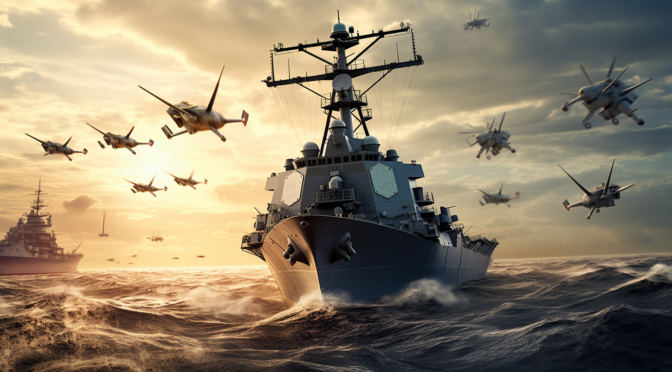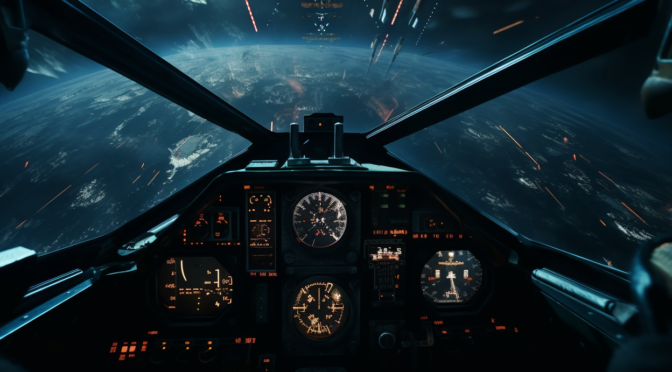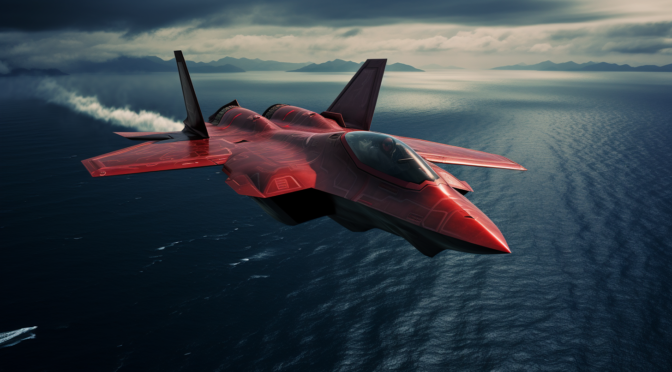By CDR Paul W. Viscovich (ret.)
“Officer of the Deck, what contact is that off the starboard bow and what’s her CPA?”
The OOD took a bearing on the distant ship from the centerline pelorus. “Skunk Lima, Captain. Closest Point of Approach is Three-Two-Five True, 12,500 yards at time 1437.”
Commander Scott Cushing swiveled his bridge chair to train his binoculars on the contact. “Does she look a little odd to you?”
“Yes, Sir. Much larger than your normal Chinese junk and she’s riding pretty high in the water. Shall we take a closer look?”
“Yes. Come right to course Three-Four-Zero. That should get us some good photos of her.”
“Aye-aye, Sir. Boats, pass the word, ‘Away the Snoopy Team, starboard side.’”
It was a clear day with excellent visibility, sea state two. As USS Barry’s intel team assembled topside to collect whatever data they could, the CO leaned forward, watching as the distance to the junk closed. No doubt they’d get some good shots of this strange ship, her bat-wing sails flapping limply in the light air.
“What the hell?”
A small, unmanned aerial vehicle dropped out of nowhere and hovered just feet away from the bridge windows, apparently scrutinizing the captain as he stared back.
“Sir! Lookouts report aerial drones just yards away off the starboard beam, port quarter, now the starboard quarter! Jesus, they’re all over the place!”
“Sound General Quarters!” Commander Cushing punched the button for CIC on his 21MC intercom. “Combat, Captain here. Why weren’t these air contacts reported?”
“Sir, they’re not showing on the air search radar!”
“Yet here they are! Have someone tune the radar and gin up an OPREP-3 Pinnacle. Report this as an enemy contact!”
The group of little airborne drones held their positions and followed the U.S. destroyer for several minutes before disengaging and flying off toward the mainland. One carried the photograph of a visibly startled Navy commander.
_________________________________________
USS Barry’s Flash radio message had the predictable effect of stirring up some excitement at the highest levels of military leadership. President McCaffrey called for a briefing in the Situation Room early the following morning. He was the last to join the meeting. Wasting no time, he turned to his Director of Central Intelligence.
“Well Hank, what are we to make of this incident?”
“USS Barry managed to get a good photograph of one drone. It’s a quadcopter, quite small, and appears to be unarmed. Initial assessment is they’re reconnaissance assets.”
“How far off the coast was Barry?”
“About 25 miles out at the time of the encounter. Short trip for those UAVs. Could be off-the-shelf models.”
“Except for one thing,” interrupted the Chief of Naval Operations. “Barry detected no unusual electronic signals before or during the encounter. The very precise navigation and situation-awareness demonstrated by these drones suggests autonomous control. Onboard Artificial Intelligence could account for that.”
“Yes, maybe. We’ll look into it” replied the DCI.
“Do we have anything like this in the works?”
“No, Sir” replied the CNO. “But I can assure you, we’ll have a Request for Bids on the street by the end of the week.”
“Anything else?”
“Well Sir, since we’re discussing China, our sources confirm they’ve suspended work on building those aircraft carriers. It looks like they’ve shifted gears and are laying the keels for quite a few much smaller ships.
“How small?”
“About the same size of one of their Coast Guard’s 1,300-ton patrol cutters.”
“This could indicate an impending move to dominate the South China Sea” offered the DCI.
“Then we should alert Jakarta, Manila and Hanoi to this possibility.” The President continued, “While I’m thinking of it, any update on what’s causing those massive smoke plumes over Huangpu?”
“No Sir.”
“Well stay on it. They’re a major violation of the Paris Climate Accords!”
_________________________________________
The contract was eventually awarded to Scythia Corporation. Their proposal was breathtaking in its originality. It would use an experimental crystalline-reformation technology to create hundreds of thousands of UAVs no larger than a fruit fly. These stealthy swarms would carry with them sufficient AI coding to evade obstacles, bad weather and human countermeasures. Upon locating their target, they would combine into temporary macroforms to create cameras, light sources, data storage, transmitters, and so on to do the work now performed by highly visible, expensive, and vulnerable drones.
The leadership at Scythia eagerly announced “Project Panopticon” in an unclassified employee briefing at their corporate headquarters in Palo Alto. The CEO concluded his remarks with,
“While I can’t go into too many specifics here, suffice it to say we are combining several of our current R&D projects into this one, which will take aerial surveillance forward by at least an order of magnitude. Panopticon will use tiny, airborne units that operate independently. If necessary they can individually fly under a door then work together to capture and deliver high resolution photographs. With it, we will not only keep several production lines working, we’ll be able to hire many new workers to support our expected expansion.”
This stunning announcement was met by a murmur of excitement from the audience.
“I’ll take any questions at this time.”
A young engineer from R&D hesitantly approached a microphone. Clearing his throat, he adjusted the mic to eliminate the feedback squeal. “Sir, what you have described is no doubt a triumph of engineering and will give a tremendous boost to our reputation.
“But I have misgivings over our partnership with the Pentagon. This new technology, who can say how they will use it? At what point might they decide to take it beyond surveillance and into combat? Killer drones could increase battlefield lethality as dramatically as the machine gun once did. Or what if it’s used for domestic surveillance, sneakily intruding in peoples’ bedrooms?
“Before moving forward on this, could we just think about the intangible costs, and our social responsibilities? Thank you.”
The audience applauded his remarks with great enthusiasm. Many stamped their feet and whistled. At the podium, the Director of Personnel leaned over and whispered to the CEO, “You know, this social responsibility thing could work out for us in the long run. Taking a bold stand as an ethical company could very well attract some of the best young talent in Silicon Valley.”
The CEO nodded. “I’m intrigued by that possibility. Gotta discuss it with the board first, but I’m thinking maybe we should take a pass on Panopticon. The technology is so new, it could easily turn into a money pit.
“Oh, and find out who that fellow is who spoke up and schedule a meeting. I like his guts and the way he thinks about the big picture. It hints at managerial potential.”
“Doing what? What are you thinking?”
“I might offer him a Directorate. If he works out there, great. And if this new antiwar orientation hurts the company, I’ll be able to fire him from a high-paid position to punish him!”
A week later, Business Insider reported Applied Symbiosis had picked up the Pentagon’s big aerial surveillance contract. They were a reliable company with a proven track record. Their proposed use of a more traditional approach to UAV technology would also cost much less.
_________________________________________
(Months later aboard USS Sailfish.)
“Conn, Sonar, strong contact bearing Two-Eight-Three. Machinery noises and blade rate similar to those over-sized junks.”
“Sonar, Conn aye.” The submarine’s OOD looked to the captain, who nodded assent.
“Diving Officer, Conn, make your depth One-Five-Zero feet.”
After clearing the boat’s acoustic baffles, he ordered “Up scope. Diving Officer, make your depth Eighty-five feet.”
A brief look confirmed a massive junk passing north bound, just inside China’s territorial limits.
“Officer of the Deck, come right to a new course that’ll let us shadow her. I want to see if she turns into the port of Shauntou like those others.”
“Aye-aye Captain. Helm, right fifteen degrees rudder, steady course Zero-Three-Three.”
_________________________________________
The next President’s Daily Brief included an assessment of several such sighting reports. The CNO opened his remarks with,
“Chinese military activity in the South China Sea is ramping up. Their fighter aircraft are closely shadowing our reconnaissance planes and they’ve sent in a squadron of Coast Guard patrol boats to interfere with neutral fishing boats.
“In the Taiwan Strait, our surface and submarine units report an uptick in coastal traffic of those super junks from Huangpu to Shauntou. One-way only. So far, none have left the port. Several reports highlight an abnormally strong radar return for wood-hulled vessels. Given this plus their size, we think they may be transporting steel or heavy equipment. There is also a recent increase of rail traffic into and out of the port.”
“Where’s Shauntou on the map? I see, thank you. Is its proximity to Taiwan significant?”
“It’s possible, but if you’re asking about a threat to Taiwan, we consider it unlikely. China has nowhere near the shipping it needs to carry an invasion force across the strait. We’re more concerned with its proximity to the South China Sea. Those small combatants being built there suggest they’re preparing for a major move in that direction. In fact, we think the super junks are directly supporting that construction.”
“It’s a damn shame we can’t see into Huangpu. I’d really like to know what they’re up to.”
_________________________________________
Higher precedence radio messages were printed in Radio Central for hand-delivery to the CO. On this morning, USS Ross’s Chief Radioman took the opportunity to escape the din and stale atmosphere of Radio Central to deliver this one personally. He could use a breath of fresh air and a view of the sunrise. But climbing three levels to the bridge left him unexpectedly winded. He stood at the back of the bridge for a long moment to catch his breath.
“Daily workout, Chief?” teased the Boatswains Mate of the Watch.
“Wait ‘til you’re my age, kid.” He crossed the deck, zig-zagging past the helm, around the chart table and over to the captain, seated in his bridge chair.
“Good morning, Sir! This OBOE from our Task Group Commander just came in.”
“Thank you, Chief.” He set his coffee on the angle-iron beneath the bridge windows and unfolded the Immediate Precedence message.
“Officer of the Deck? You should see this.”
It was an operational directive tasking their guided missile destroyer to take a closer look at a super junk.
“Well, Skipper, this could add some excitement to our day.”
“No kidding. Pass the word for the XO and Ops to join me on the bridge.”
The wait was not long. Toward the end of the forenoon watch one of the super junks came into view.
“Officer of the Deck, sound General Quarters. Increase speed to ahead full and maneuver to intercept.”
“Aye-aye, Sir!”
The crew was well trained and motivated. It took only a few minutes for all stations to achieve manned and ready. The GQ Officer of the Deck reported this to the captain.
“Very well! Now call away the Security Alert Team to the Flying Bridge, Backup Alert Force to the Flight Deck. If they swarm us with those drones, I want to be ready!”
All hands stood quietly alert at their battle stations as the range between the ships decreased.
“Bridge, Combat. High speed surface contact bearing Zero-Zero-Five, range 21,500 yards. Designated Skunk Romeo.”
Moments later the Bridge Status Board Keeper barked, “Forward Lookout reports new contact on the starboard bow, correlates to Skunk Romeo. Looks like a patrol boat with a bone in its teeth!”
The Chinese patrol boat intercepted the DDG before it could get close to the junk. It sounded five short blasts, the danger signal on its horn and maneuvered aggressively into the path of the warship. Simultaneously a flight of about a dozen UAVs descended on the ship in a harassing manner, like terriers nipping the heels of a cow. This was too much.
“Pass word to the SAT and BAF, shoot down those drones! Just avoid firing in the direction of that patrol boat. Acknowledge!”
Despite their best efforts, the Ross’s bridge team could get no closer than four miles from the junk. The nimble patrol boat skillfully cut off the warship at every turn. Peacetime Rules of Engagement did not permit Ross to ram it.
_________________________________________
This was the last encounter between the two great powers over the junks. The following day, when satellite imagery suggested the port of Shauntou could hold no more, a score of the newly constructed patrol boats got underway, taking station all over the Taiwan Strait. Some aggressively shadowed any allied warships while the others conducted what were obviously anti-submarine warfare patrols. These were not China Coast Guard patrol boats. They were submarine-hunting naval corvettes.
In Washington, President McCaffrey called the National Security Council into emergency session. He went straight to the point.
“What is going on in the Taiwan Strait?”
“Sir, the situation is rapidly developing …”
“One might say, ‘deteriorating’ …”
“Yes, Sir. There has been a surge of those small combatants out of Shauntou, harassing our warships and submarines.”
“How much? How belligerent are they?”
“Dangerously close to triggering a self-defense response from our ships. For now, Seventh Fleet has authorized Warning Red, Weapons Tight. The Chinese are swarming our destroyers with corvettes and drones. Their ASW units are saturating the strait with active sonar, leaving no refuge for our subs.”
“What? Can’t they just go ‘under the layer’ as I think you call it?”
“No, Sir. The Strait is so shallow, there is no thermal layer.”
“What reconnaissance assets are we using?”
“Right now, satellite imagery is all we’ve got.”
“Director, what are the satellites showing?”
“Quite a bit, but let me start with something too crazy to be true. It looks like all those super junks are being dismantled at their piers!”
“Why would they do that? It makes no sense. They’ll sink their own ships pierside! Anything else?”
“Those smoke plumes over Huangpu have dissipated. Satellite imagery shows nothing unusual.”
“’At least not now’ you mean.”
_________________________________________
“Bridge, Combat. Multiple surface contacts to the north, range to the nearest is 30,500 yards. Looks like a line of ships exiting the port of Shauntou.”
“Bridge, Combat, TAO speaking! Sonar reports explosive detonations bearing Zero-Seven-Five. Sounds like depth charges!”
“Combat, this is the captain. Warning Red, Weapons Free, I say again, Weapons Free!”
“Weapons Free aye, Sir. OPREP-3 Pinnacle to follow.”
“Very well! Officer of the Deck, sound General Quarters! Make your course Zero-Seven-Five, Ahead Flank, turns for thirty knots. If they’re attacking one of our subs, we’re joining the fight!”
A strident voice came over the bridge speaker for the Primary Tactical frequency. “All units, this is Poseidon Two Five, have visual contact on numerous ships departing Shauntou. Small warships screening what appear to be troop transports or landing ships.”
“Troopships?” Wondered the OOD. “Where’d they come from?”
“Inside fake wooden hulls is my guess,” growled the captain.
“Mayday, mayday, mayday! Any station, any station, this is Poseidon Two Five! Am under attack by fighter aircraft over Taiwan Strait …”
The voice on PRITAC died. The 21MC crackled to life: “Vampires! Vampires bearing Three-Zero-Zero!”
“Shit! Air action to port!”
_________________________________________
The faces around the National Security Council’s conference table looked worn and worried. The Secretary of State broke the silence. “Beijing is warning us to stay out of what they call a strictly internal matter of the People’s Republic.”
“Oh really,” replied the president. “Their attack on our naval and air assets demands a strong response, an iron-fisted reply. We will stand by our friends in Taipei.”
“The military is at DEFCON One worldwide,” reported the Chairman of the Joint Chiefs. “What are your orders, Mister President?”
“We will craft an appropriate response before we leave this room. The energetic self-defense measures of our ships and aircraft are a good start. But I hate going to war blind. The way the Chinese were able to keep this invasion under wraps the way they did, well, there’s no other way to describe it.”
No one spoke.
“This is probably the biggest intel failure since Pearl Harbor. How did we allow this?”
No one made eye contact. Collectively they had failed.
“It would’ve been nice to know what the Chinese were hiding with those smoke plumes. Which reminds me, didn’t we have some next-generation spyware in development? Panoptic-something?”
“We did. The winning contractor pulled his bid, so we awarded the project to another. Unfortunately, that one’s still in R&D because it’s not stealthy enough,” confessed the Chairman.
“We need answers and action. Can we look at making an emergency award to that first contractor? We all liked their concept.”
“I’ll check but the answer is probably no. The contractor, Scythia, is focusing all its resources on developing a zero-carbon propulsion system for use in the fleet.”
“What? We already have those! They’re called nuclear reactors. Now show me where our carriers are!”
Paul Viscovich is a retired Commander and Surface Warfare Officer with 20 years service. He graduated from the U.S. Naval Academy in 1975 and earned a Master of Sciences degree from the Naval Postgraduate School in 1987. He writes a current events newsletter on Substack.com and is working on an anthology of short stories, many with a nautical theme. He lives with his wife Christine in Weston, FL.
Featured Image: Art created with Midjourney AI.




